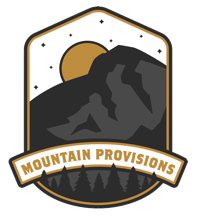The Big Three in backpacking: Shelter, sleep system (bag and pad), backpack
Backpackers should always be concerned about the weight they are carrying. Carrying less weight will allow you to hike farther, faster, more efficiently, and theoretically more comfortably. The reason I say “theoretically” is because there is a ton of nuance to the equation! Let’s clear up some terminology first.
Base Weight: The combined weight of everything on your packing list excluding consumables (food, water, and fuel). Consumables are excluded because they vary based on trip duration and weather conditions.
Lightweight backpacker: Carries a base weight of less than twenty pounds.
Ultralight backpacker: Carries a base weight of less than ten pounds.
Now for the nuances…
Packs: Going light or ultralight comes with trade-offs. Light and ultralight packs can be really comfortable as long as you don’t overload them! True, a frame built into a pack adds weight but it also adds the ability to carry heavier loads more comfortably. Once you start stripping away the support structure of the pack you are going to be uncomfortable unless you can simultaneously drop the overall weight you are carrying.
When you are pack shopping have an ideal and worst case scenario in mind as to how much weight you will be carrying and make sure you try the pack on and have it fitted with that amount of weight in the pack. You want to get a realistic feel for what the pack will feel like with the load you plan on carrying. If you already own most of the gear counting toward your base weight, bring it to the shop with you. If not, any properly equipped shop should be able to simulate the weight with gear from the shop or with weight bags and fillers.
As packs get lighter they also get more stripped down to save weight. First to go are interior and most exterior organizer pockets. Next the lid goes away. Finally, most, if not all, of the frame and padding get the axe. By this point if you’re carrying much more than fifteen pounds you’re going to pretty miserable.
Sleep System: I use the term sleep system in place of sleeping bag and pad because the two should be thought of a combined system rather than the individual parts. The sleeping pad makes for a more comfortable night’s sleep in two important ways. It provides padding from the ground but more importantly it also provides insulation. The dead air space created by the loft in your sleeping bag provides lots of warmth, but when you lay on it you temporarily crush all the loft and corresponding insulation. That’s where the sleeping pad comes in to save the night’s sleep. Think of it this way… the pad insulates from the bottom and the sleeping bag insulates from the top.
Sleeping bags come in all kinds of shapes and sizes. The tighter the fit, the more efficient the bag will be but most of us aren’t used to sleeping like mummies. Thankfully, manufacturers like Big Agnes and Nemo Equipment have now started making high performance, light weight bags shaped in ways that are way more comfortable to sleep in.
Shelter: Freestanding tents are the most popular but also the heaviest option. That said, they are way lighter than they were even 10 years ago. My first backpacking tent was seven pounds. My current one is less than three pounds. What makes a tent freestanding is the ability to pitch it without having to stake it out in order to keep the tent upright. Tarps and other non-freestanding shelters can be great lighter weight options but keep in mind that staking is a must and set-up will go much more smoothly if you aren’t trying to do it by yourself. Similarly, hammocks can be a great option but again there are limitations. You need to find trees the right distance apart or carry extra rope which may offset the weight saved by ditching the tent.
The big takeaway: As thru-hikers say “HYOH” (Hike your own hike). There are a ton of options out there! Some are better constructed than others. Some are more durable than others. Some are lighter than others. Some are more comfortable than others. Everyone has different priorities and budgets. Go talk to one the experts at your locally owned outdoor specialty shops to help sort out what are the best options for you!
